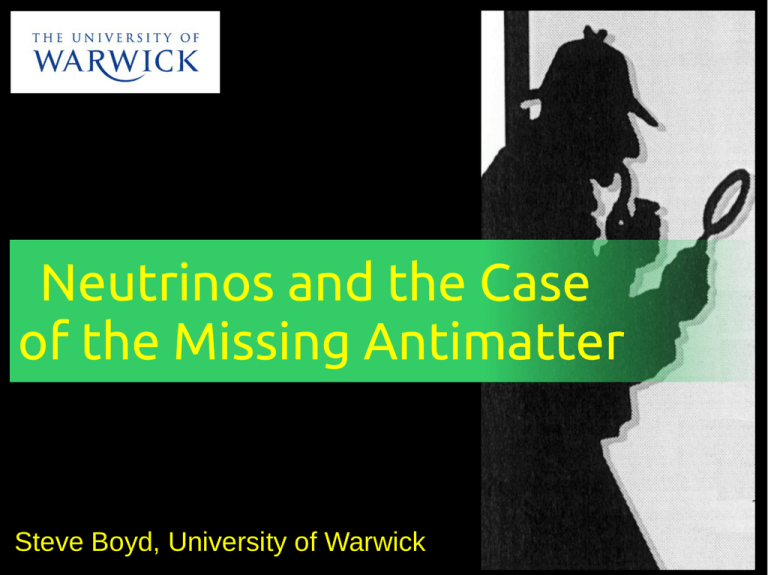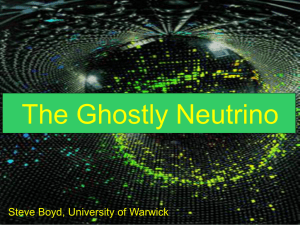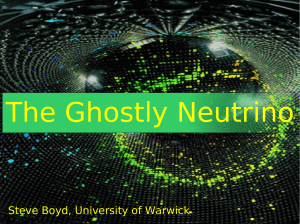Neutrinos and the Case of the Missing Antimatter
advertisement

Neutrinos and the Case of the Missing Antimatter Steve Boyd, University of Warwick Where is all the antimatter? Matter quark Negative electric charge Anti-Matter anti-quark Positive electric charge Predicted by Dirac in 1928 Discovered by Anderson in 1932 Matter quark Negative electric charge Anti-Matter anti-quark Positive electric charge Predicted by Dirac in 1928 Discovered by Anderson in 1932 Matter light Anti-Matter 2 E = mc Matter light Anti-Matter The reverse reaction should also happen with the same probability Equal amounts of matter and antimatter 1 atom of matter to 0.0000000001 atoms of antimatter Neutrinos The smallest, most insignificant (yet most common) particle in the cosmos may just hold the reason! This particle is called the neutrino So what is a neutrino? Neutrinos are the second most common particle in the universe. They are produced whenever something radioactively decays Electron, e Electron Neutrino, e Negative Charge Tiny mass ( 1 ) Neutral Very tiny mass (<0.0000001) x 150 Electron Neutrino, e Electron Antineutrino, e Muon Neutrino, Muon Antineutrino, Tau Neutrino, Tau Antineutrino, 3 neutrino Flavours The sun generates about 2x1038 neutrinos/s as byproducts of the fusion processes that make the star shine. So why don't we notice? are almost ghosts. They interact extremely weakly with matter. To a neutrino a planet is mostly empty space. 500,000,000,000,000 neutrinos from the sun just went through each and every one of you "The chances of a neutrino actually hitting something as it travels through all this howling emptiness are roughly comparable to that of dropping a ball bearing at random from a cruising 747 and hitting, say, an egg sandwich." Douglas Adams - Mostly Harmless Probability 1 x 10 Egg Sandwich -13 e Probability 5 x 10 e -13 How do we use neutrinos to study the matter/anti-matter asymmetry? Electron Neutrino, e Electron Antineutrino, e Muon Neutrino, Muon Antineutrino, Tau Neutrino, Tau Antineutrino, 3 neutrino Flavours Neutrino Flavour Oscillations e distance e Prob. It is 1 0 Distance Travelled How do we use this? Prob (νμ → ν e )≠Prob(ν μ → νe ) Then neutrinos behave differently from anti-neutrinos An idea floating around suggests that, if this happens, then the same thing will happen to matter and anti-matter T2K Experiment e 295 km The case of the missing antimatter For some reason the laws of physics behave differently when applied to matter than when applied to antimatter. This is the reason why there is stuff around at all. We don't know why (yet) The neutrino – the lightest and most numerous (but hardest to study) particle in the universe may just hold the key to understanding why we are here at all. The case of the missing antimatter For some reason the laws of physics behave differently when applied to matter than when applied to antimatter. This is the reason why there is stuff around at all. We don't know why (yet) The neutrino – the lightest and most numerous (but hardest to study) particle in the universe may just hold the key to understanding why we are here at all. The case of the missing antimatter For some reason the laws of physics behave differently when applied to matter than when applied to antimatter. This is the reason why there is stuff around at all. We don't know why (yet) The neutrino – the lightest and most numerous (but hardest to study) particle in the universe may just hold the key to understanding why we are here at all. So far......... There is a difference between the physics of matter and antimatter. It's name is CP Violation LHCb The LHC will study this by looking differences between particles called B0 and B0 mesons 1 kilogram of matter + 1 kilogram of antimatter x2 Neutrino Oscillations THE most important discovery about neutrinos in the last 20 years l l A typical neutrino experiment Neutrino Oscillations lepton another type of lepton A typical neutrino experiment Neutrino Oscillations lepton another type of lepton A typical neutrino experiment It's Quantum..... 3 | ν α >=∑i=1 U αi | ν i > where Uαi is a unitary matrix | ν k (t , x )>=e i( E t − p x) | ν k ( 0,0)> → P( ν α ( 0,0) → νβ (t , x ))=| < ν β ( t , x)| ν α (0,0) > |2 k k | < ν β (t , x) | ν α (0,0) >| 2=∑k ∑ j U α k U *α j U β k U *β j ei ((E −E )t −( p − p ) x) j k j k ( E j −Ei )t −( p j− p i) x=( √ p +m −√ p +m ) x −( p j −p i) x = 2 j 2 j 2 i 2 i 2 2 2 m m Δ m 1 j 1 i ij ( p j (1+ )− p i (1+ ))≈ 2 pj 2 pi 4E ( U= cos θ sin θ −sin θ cos θ ) 2 Δ m 2 2 12 L P(ν α (0,0)→ ν β (t , x ))=sin (2 θ)sin ( ) 4E Positron Emission Tomography (PET)






